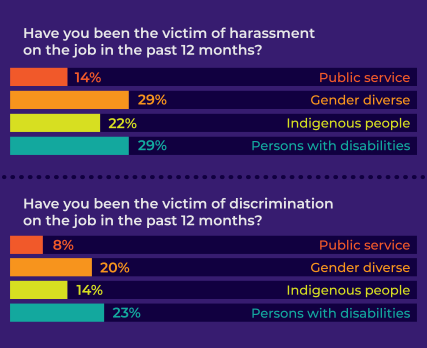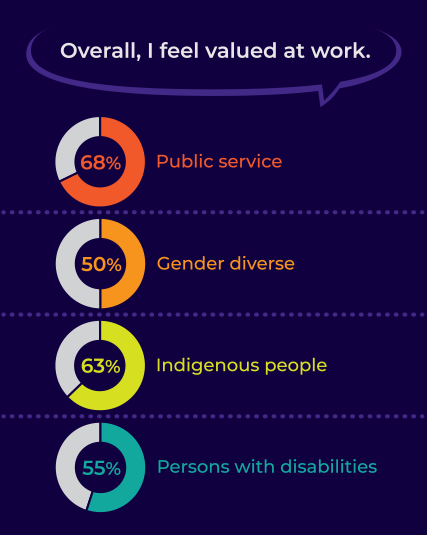The most recent results from the Public Service Employee Survey show that, despite some improvements over the years, significant barriers remain for marginalized groups. The annual survey, which asks questions about peoples’ experiences at work, provides a picture of the reality facing workers from diverse groups, and that picture is not always a rosy one.
Discrimination and harassment still a problem
Discrimination and harassment at work remain a significant problem for persons with disabilities and gender diverse* people, who reported the highest levels in the public service. About one in five employees in each of those groups reported having been the victim of discrimination in the past year, and almost one in three said they had been harassed. Indigenous employees also reported significant levels of discrimination and harassment, at 14 and 22 per cent, respectively.
Twelve per cent of racialized employees and 11 per cent of those who identified as lesbian, gay, bisexual or another sexual orientation (LGB+)** reported discrimination.
“While rates of discrimination and harassment have fallen over the last decade, these statistics remain disturbingly high,” said Chris Aylward. “The public service should be a good place to work for everyone.”
Workplace environment and well-being
Disappointing results were also seen when it comes to how members of equity-seeking groups experience their workplace on a day-to-day basis.
For example, gender diverse people and persons with disabilities and were significantly less likely to report:
- feeling valued at work (50/55% versus 68% average)
- being accepted as a team member (61% versus 75% average), or
- being treated with respect by their department/agency (63/68% versus 82% average)
Work-related stress is also higher for members of most equity groups: 30 per cent of gender diverse people, 29 per cent of persons with disabilities, 20 per cent of Indigenous people, and 19 per cent of LGB+ people said that their level of work-related stress is “high” or “very high” (compared to an average of 16 per cent for the public service). As well, only 37 per cent of gender diverse people and 46 per cent of persons with disabilities said that they would describe their workplace as psychologically healthy, compared with 61 per cent of the overall public service.
Accessibility and accommodation
Accessibility and workplace accommodation are issues that have a significant impact on employees with disabilities. Without proper access or accommodation, employees with disabilities don’t have the same opportunity as others to succeed at work, and in some cases, can’t even stay in the workplace.
More than half of employees with disabilities reported having requested accommodation at work, with 17 per cent of those saying that no measures were taken to accommodate their needs. Of those that were accommodated, 22 per cent were not satisfied with the accommodation measures taken by the employer.
Not surprisingly then, more than one in four employees with disabilities said that accessibility or accommodation issues have adversely affected their career progress and one in three said those issues cause them stress at work.
“PSAC is urging the government to take these results seriously and address them,” said Aylward. “One way they can start to do that is to implement all of the recommendations of the Joint Union-Management Task Force on Diversity and Inclusion”.
The Joint Task Force had a one-year mandate to define, establish the case, and make recommendations towards a framework and action plan to improve diversity and inclusion in Canada’s public service. Its final report contained 44 recommendations for government to improve the diversity and inclusion in the public service.
Notes
* “Gender diverse” is the category used in the survey results to refer to those who identified their gender as something other than male or female in the survey.
**Respondents were given the choice of identifying as heterosexual, gay, lesbian, bisexual, or some other sexual orientation (specified by the respondent). For our analysis, we have grouped all of the responses together that were in the gay, lesbian, bisexual, or “other” categories.
 Member Login
Member Login



